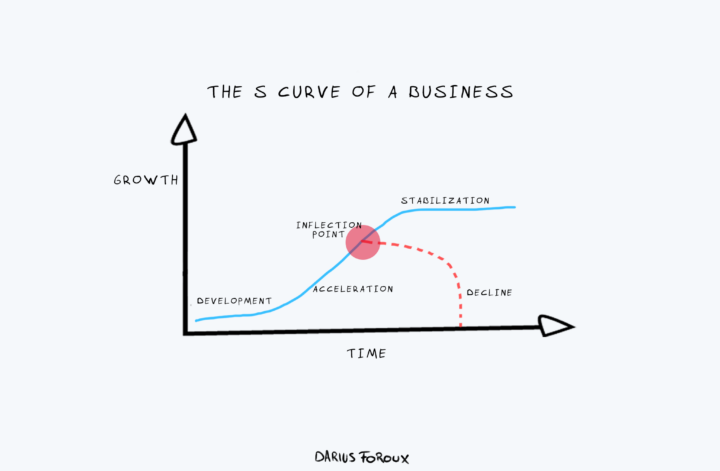In 1984, Intel Corporation was a leading producer of memory chips. But as Japanese competitors like Toshiba and NEC came to the US, Intel started to lose its market share. This is where the inflection curve of a business typically happens: When a new player suddenly changes the market.
The Japanese were cheaper and better. Intel tried to compete harder. Some executives believed Intel had to build a new factory. Make cheaper memory chips.
But Andrew Grove, then CEO of Intel, slowly started to realize that memory chips had no future. Grove, the third employee at Intel, was a visionary who had a knack for seeing where the industry was heading before others did. He was known for his pragmatic approach to business and his dedication to innovation.
By 1985, Grove decided that Intel had to move towards microprocessors. At the time, this was not an easy choice. While microprocessor chips were becoming increasingly important parts of the computer revolution, they weren’t considered as crucial as today.
Now, microprocessors like CPUs and GPUs are at the heart of the tech industry. But back then, that wasn’t the case. In fact, most of Intel’s business was still stuck in the chip industry.
To middle managers of Intel, Grove’s pivot to microprocessors was ridiculous. And they weren’t immediately proven wrong. Intel has been slowly building its microprocessor products since 1971, with little market success. Even when Grove focused the company on microprocessors, things weren’t profitable immediately.
Until the personal computer (or PC as we know it) gained popularity in the 90s. The shift towards microprocessors turned out to be a golden one. And Intel became one of the most important tech companies in America.
Strategic inflection points
Andrew Grove, wrote about the whole shift towards microprocessors in his book, Only The Paranoid Survive. He talked about that period as a “strategic inflection point.”
Here’s how he explained the concept:
“A strategic inflection point is a time in the life of business when its fundamentals are about to change. That change can mean an opportunity to rise to new heights. But it may just as likely signal the beginning of the end.”
Visually it looks like this:
Here’s what Grove said about the inflection point:
“Mathematically, we encounter an inflection point when the rate of change of the slope of the curve (referred to as its “second derivative”) changes sign, for instance, going from negative to positive. In physical terms, it’s where a curve changes from convex to concave, or vice versa. As shown in the diagram, it’s the point at which a curve stops curving one way and starts curving the other way.”
Whether you’re a CEO, business owner, or an individual who’s managing your career, you must be aware of strategic inflection points.
When something changes in the environment, the question is: How do you react?
As the tech industry in the 80s started to see more competition and new products, Intel decided to pull the plug on its main product and create something different.
These things happen a lot in business. But also in careers.
If you feel like your job or career is changing, maybe even becoming obsolete, you must learn new skills to thrive.
Spotting inflection points and reacting to them
In hindsight, it’s really easy to detect inflection points. For instance, if we look back on the 2010s, it’s easy to see that publicly traded consumer tech and media companies like Facebook, Apple, Netflix, and Google were good investments.
But I remember that there was always criticism of those companies in the last decade. Now, they are responsible for the massive growth of the stock market.
As Andrew Grove wrote, it’s hard to spot inflection points in real-time:
“All businesses operate by some set of unstated rules and sometimes these rules change often in very significant ways. Yet there is no flashing sign that heralds these rule changes. They creep up on you as they crept up on us without warning.”
For Intel, it took several years to realize they were being outcompeted. And a few more years to make the change. You must be aware of your environment and not be afraid of making hard decisions.
Especially when you notice that some things are not working anymore. Grove continued:
“What worked before doesn’t work anymore; you need to steer the boat in a different direction quickly before you are in trouble, yet you have to get a feel of the new direction and the strength of the wind before you can hope to right the boat and set a new course.”
He concluded that the key is to (1) recognize that things are changing, and (2) to take action:
“So the ability to recognize that the winds have shifted and to take appropriate action before you wreck your boat is crucial to the future of an enterprise.”
Your job as a leader is not only to make your business or career functioning well today. But also to ensure you stay successful and relevant in the future.





